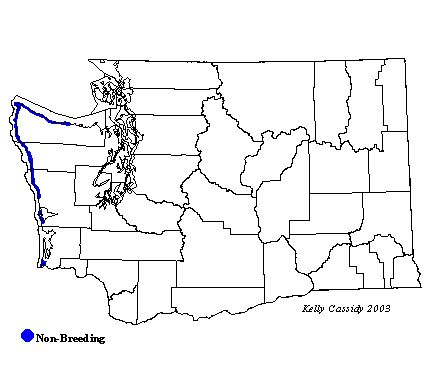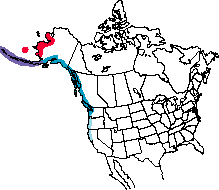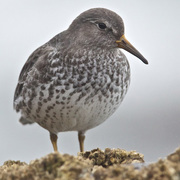Rock Sandpiper
General Description
A heavily speckled, cryptic bird, the Rock Sandpiper is well camouflaged. The adult in breeding plumage is reddish above, with gray wings. Its bill is slightly drooped and of medium length. It has a heavily streaked neck and breast, reddish-brown cap, and dark patch on its cheek. It has a dark patch on its belly that does not extend behind its legs (as in the Dunlin). Its legs are gray in the breeding season, but turn to yellow in the non-breeding season. Non-breeding birds are gray with white-edged feathers, giving them a scalloped look overall. The juvenile appears similar to the adult in breeding plumage, but lacks the reddish-brown cap and dark belly. Since adult birds molt on the breeding grounds before migrating south, juveniles should be easily distinguished from adults when they first arrive in Washington in the fall.
Habitat
During the breeding season, Rock Sandpipers inhabit dry, barren tundra. The rest of the year, they are rarely found away from the habitat from which they earned their name. They usually forage below the tide line of rocky beaches and jetties on the Washington coast.
Behavior
In Washington, Rock Sandpipers are usually found singly or in small groups, in flocks with Black Turnstones and Surfbirds. They are fairly gregarious, but will sometimes gather in groups separate from the other rock shorebirds. Unlike their counterparts on the rocks, Rock Sandpipers do not chip or pry attached prey from its substrate. They move slowly along and pick up moving prey from the crevices and seaweed among the rocks.
Diet
Rock Sandpipers are unusual among shorebirds in that they commonly eat vegetable matter, including seeds, berries, moss, and algae. They also eat invertebrates, including mollusks, crustaceans, and marine worms.
Nesting
The nest of the Rock Sandpiper is located on the ground in the open, dry tundra, often on a raised area of lichen or moss. The male begins a deep scrape, and the female may help by adding lichen, leaves, or grass. Both parents help incubate the four eggs, although the male may provide most of the incubation, which lasts for about 20 days. The chicks leave the nest soon after hatching and feed themselves. The male usually tends the brood, although sometimes both parents or only the female will do so. The young probably begin to fly at about three weeks.
Migration Status
Adults molt on the breeding grounds before migrating south, so southward migration is late in the fall. Some populations that breed on islands off Alaska are resident. The populations that migrate winter along the Pacific coast to northern California.
Conservation Status
The Canadian Wildlife Service estimates the global population at 200,000 birds, with 150,000 breeding in North America. The remainder breed on the northeast Asian coast. The Rock Sandpiper has been declining in this state for unknown reasons since the 1970s. This decline is only in the southern end of their winter range and has not been reflected on their breeding grounds. Rock Sandpipers are listed as an at-risk species on the Partners in Flight watch list, and more study is needed to understand the factors contributing to their decline.
When and Where to Find in Washington
The Rock Sandpiper is an uncommon species found on jetties (such as the jetty at Ocean Shores) and the rocky shores of coastal Washington from October to mid-May. Rarely, a few birds are seen at either end of that time period, as early as August, and as late as the end of May. Rarely, birds are seen in protected waters, south into Puget Sound as far as Seattle. They have not been recorded in eastern Washington.
 Abundance
Abundance
| Ecoregion | Jan | Feb | Mar | Apr | May | Jun | Jul | Aug | Sep | Oct | Nov | Dec |
|---|---|---|---|---|---|---|---|---|---|---|---|---|
| Oceanic | ||||||||||||
| Pacific Northwest Coast | U | U | U | U | R | U | U | U | ||||
| Puget Trough | R | R | R | R | R | R | R | |||||
| North Cascades | ||||||||||||
| West Cascades | ||||||||||||
| East Cascades | ||||||||||||
| Okanogan | ||||||||||||
| Canadian Rockies | ||||||||||||
| Blue Mountains | ||||||||||||
| Columbia Plateau |
Washington Range Map

North American Range Map


Family Members
 Spotted SandpiperActitis macularius
Spotted SandpiperActitis macularius Solitary SandpiperTringa solitaria
Solitary SandpiperTringa solitaria Gray-tailed TattlerTringa brevipes
Gray-tailed TattlerTringa brevipes Wandering TattlerTringa incana
Wandering TattlerTringa incana Greater YellowlegsTringa melanoleuca
Greater YellowlegsTringa melanoleuca WilletTringa semipalmata
WilletTringa semipalmata Lesser YellowlegsTringa flavipes
Lesser YellowlegsTringa flavipes Upland SandpiperBartramia longicauda
Upland SandpiperBartramia longicauda Little CurlewNumenius minutus
Little CurlewNumenius minutus WhimbrelNumenius phaeopus
WhimbrelNumenius phaeopus Bristle-thighed CurlewNumenius tahitiensis
Bristle-thighed CurlewNumenius tahitiensis Long-billed CurlewNumenius americanus
Long-billed CurlewNumenius americanus Hudsonian GodwitLimosa haemastica
Hudsonian GodwitLimosa haemastica Bar-tailed GodwitLimosa lapponica
Bar-tailed GodwitLimosa lapponica Marbled GodwitLimosa fedoa
Marbled GodwitLimosa fedoa Ruddy TurnstoneArenaria interpres
Ruddy TurnstoneArenaria interpres Black TurnstoneArenaria melanocephala
Black TurnstoneArenaria melanocephala SurfbirdAphriza virgata
SurfbirdAphriza virgata Great KnotCalidris tenuirostris
Great KnotCalidris tenuirostris Red KnotCalidris canutus
Red KnotCalidris canutus SanderlingCalidris alba
SanderlingCalidris alba Semipalmated SandpiperCalidris pusilla
Semipalmated SandpiperCalidris pusilla Western SandpiperCalidris mauri
Western SandpiperCalidris mauri Red-necked StintCalidris ruficollis
Red-necked StintCalidris ruficollis Little StintCalidris minuta
Little StintCalidris minuta Temminck's StintCalidris temminckii
Temminck's StintCalidris temminckii Least SandpiperCalidris minutilla
Least SandpiperCalidris minutilla White-rumped SandpiperCalidris fuscicollis
White-rumped SandpiperCalidris fuscicollis Baird's SandpiperCalidris bairdii
Baird's SandpiperCalidris bairdii Pectoral SandpiperCalidris melanotos
Pectoral SandpiperCalidris melanotos Sharp-tailed SandpiperCalidris acuminata
Sharp-tailed SandpiperCalidris acuminata Rock SandpiperCalidris ptilocnemis
Rock SandpiperCalidris ptilocnemis DunlinCalidris alpina
DunlinCalidris alpina Curlew SandpiperCalidris ferruginea
Curlew SandpiperCalidris ferruginea Stilt SandpiperCalidris himantopus
Stilt SandpiperCalidris himantopus Buff-breasted SandpiperTryngites subruficollis
Buff-breasted SandpiperTryngites subruficollis RuffPhilomachus pugnax
RuffPhilomachus pugnax Short-billed DowitcherLimnodromus griseus
Short-billed DowitcherLimnodromus griseus Long-billed DowitcherLimnodromus scolopaceus
Long-billed DowitcherLimnodromus scolopaceus Jack SnipeLymnocryptes minimus
Jack SnipeLymnocryptes minimus Wilson's SnipeGallinago delicata
Wilson's SnipeGallinago delicata Wilson's PhalaropePhalaropus tricolor
Wilson's PhalaropePhalaropus tricolor Red-necked PhalaropePhalaropus lobatus
Red-necked PhalaropePhalaropus lobatus Red PhalaropePhalaropus fulicarius
Red PhalaropePhalaropus fulicarius

